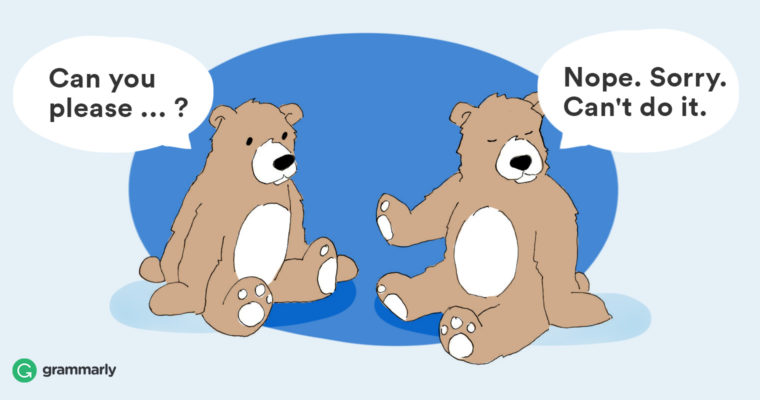
No is one of the shortest words in English, but it’s also one of the most difficult to say. The problem isn’t pronunciation. Many people feel guilty when they have to turn down a request—especially one from a friend, colleague, or family member.
Saying no in the workplace
How can you decline a request without those pesky feelings of guilt? Let’s look at some scenarios you might face at the workplace. Why is saying no the right thing to do in each situation?
Why it’s okay to say no
Is providing tech training part of your job description? If not, you have no obligation to do it. Sue would learn best from a willing teacher. If you politely refuse, you’ll avoid doing her a disservice, and she’ll be free to find a teacher committed to her success.
How to say no without guilt
Thank your colleague for complimenting your abilities. Point out that while you are familiar with the program, you are not much of a teacher. Suggest another way for her to accomplish her goal. For example, you might send her a link to an online tutorial that helped you or encourage her to ask the boss to arrange training for everyone who needs support.
Why it’s okay to say no
Mental health experts encourage a healthy work-life balance. If work always crowds out your other interests, you’ll soon experience burnout that will prevent you from working at your highest potential. In this case, saying no will set a precedent for your work relationship in the future. Your boss might never respect your “no” if you weaken and give in to his request. If the special event is important and you’ve followed company procedures, you shouldn’t feel bad about taking time for yourself.
How to say no without guilt
When dealing with authority, you might propose a compromise. “Thanks for inviting me to work on the project! Though I won’t be available to reschedule my commitments Saturday, I cleared my schedule to work on the project as soon as I return to the office. I will report to you first thing Monday to see what you need me to do.” A tactful, yet firm response will show your boss that while you’re not a pushover, you are still a team player.
Why it’s okay to say no
An editor’s comments are suggestions for improvement. You, as the person whose name is on the article, will be the one to take the credit for successes and the fall for any mistakes. If your research or experience moves you to reject the advice, you can do so with the confidence that editors aren’t infallible.
How to say no without guilt
Focus on how saying no will benefit your colleague. For instance, you might include a reference to the issue in the most recent style guide. Often, posing your challenge in the form of a question will help you show respect. “I thought that the 2017 Chicago Manual of Style discouraged the use of singular they (in place of he or she) in formal prose? Can you check on it and get back to me?” You can also choose to ignore the suggestion without an explanation. Doing so might cause your editor to do a little investigating of her own and save herself the embarrassment of receiving a correction from you.
Practice makes perfect
Does the thought of saying no still put you on edge? You’re not alone! Psychologist Marsha Linehan suggests practicing in unimportant daily situations. Smile and shake your head the next time someone offers you a free sample at the mall. Delete the next email for a volunteer work project. In time, you’ll lose the feeling that you always have to say yes.
Why does saying no have to be a negative experience? Remind yourself why saying no is the wisest course. Then, use a little tact as you explain why you’re declining. If you offer an alternative means to support the person, they will feel better and so will you.
